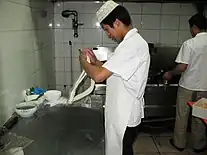.jpg.webp) A bowl of lanzhou beef noodle soup | |
| Alternative names | Lan zhou la mian |
|---|---|
| Type | Noodle soup |
| Region or state | East Asia |
| Main ingredients | Beef, beef broth, vegetables, Chinese noodles |
| Lanzhou beef noodle soup | |||||||||||||||||||||||||
|---|---|---|---|---|---|---|---|---|---|---|---|---|---|---|---|---|---|---|---|---|---|---|---|---|---|
| Simplified Chinese | 兰州牛肉面 | ||||||||||||||||||||||||
| Traditional Chinese | 蘭州牛肉麵 | ||||||||||||||||||||||||
| |||||||||||||||||||||||||
Lanzhou beef noodle soup or Lanzhou ramen is a variety of beef noodle soup. This dish has an extensive history, and the recipe differs by region due to cultural factors, availability of ingredients, and local innovations.
History
.png.webp)
It is said that Lanzhou, China has three local treasures. As the saying goes, "auspicious gourd and beef noodles, and sheepskin raft like warship". One of the oldest beef noodle soups is the Lanzhou hand-pulled noodle or Lanzhou lamian (Chinese: 兰州拉面) in Mandarin, which was originated by the Hui people of northwest China during the Tang dynasty.[1][2] Though there is some debate about when Lanzhou hand-pulled noodles originated, the recipe is named after the major city in Gansu Province, Lanzhou City, which stretches to the Yellow River and was a stop on the ancient Silk Road. The Hui Muslim population or Hui People developed a variation of beef noodle soup noodle that is compatible with the Muslim diet with easy to prepare ingredients.[3] There are numerous beef noodle soups available in China, with a wider variety in the west than the east.
Description
Lanzhou beef noodle soup is a Chinese Muslim style of beef noodle soup, also known as clear-broth or consommé-stewed beef noodle (清炖牛肉面). It often uses halal (or qingzhen) meat and contains no soy sauce, resulting in a lighter taste that may be flavored by salt and herbs. Local lore attributes its creation with a Hui Chinese man from Lanzhou named Ma Baozi (马宝子).[4] In Lanzhou, the capital of Gansu province, Lanzhou Beef Lamian (兰州牛肉拉面) is usually served with clear soup and one hand-pulled lamian noodle per bowl. In halal restaurants, only quality local beef from the Southern Yellow cattle (黄牛; 'yellow cattle') prepared by the local halal butcher is used.[5] Chinese radish and a specially cooked spicy oil are also indispensable partners to Lanzhou beef noodles. To identify the ingredients and the dish, the local government news company suggests preparing the soup by the following five steps: "One Clear, Two White, Three Red, Four Green, Five Yellow" (一清、二白、三红、四绿、五黄). First, the beef soup should look clear; Second, the radish slides should be crystal white; Thirdly, the color of the chili oil should be bright red; Fourth, the green cilantro leaves and garlic shoots should be jade, and, lastly, the noodle should be smooth and bright yellow. In overseas Chinese communities in North America, this food can be found in Chinese restaurants. In Mainland China, a large bowl of it is often taken as a whole meal with or without any side dishes.
Styles
Traditional Lanzhou beef soup noodle could be made from any one of eight styles of noodles: Thinnest (毛细), Thinner (细面), Thin (三细), Thick (二细), Thicker (粗面), Prism (韭叶), Wide (宽面), and Wider (大宽).[6] Thinnest or hair thin is "a round noodle about two-thirds of the thickness of a spaghetti", and the thinner style and thin style are just about the size of spaghetti with minimal difference. The thick and thicker style is round noodles that are sized thicker than thin. Prism, wide, and wider are flat thin noodles that provide a different texture. Additionally, a more novel type of noodle is Qiaomaileng (荞麦棱), in which the noodle is highlighted by its angular shape.[7] To provide an example, take a look at the 1919 Lanzhou Beef Noodle restaurant for more information about the noodle styles.[8]
Many restaurants across the globe include but are not limited to these seven types of noodle styles. This is because of the evolution of noodle making and the combination of the local culture. According to omnivore's cookbook, the Lanzhou hand-pull noodles should be even in its width and thickness, and the ingredients should also be prepared in certain dimensions.[9] In mainland China, restaurants that specialize in Lanzhou beef noodle soup may provide customers to watch how the noodles are made, similar to the food production line layout of Din Tai Fung. The dough for hand-made noodle is normally made the day before being used, but the hand-made noodles are freshly pulled into shapes right before being cooked. The noodle pulling process is quick and can take up to several minutes, including repetitively rolling, pulling, and spinning. Right after the noodle is in shape, the noodle is boiling until fully cooked.[10]
 Lanzhou beef noodle, with clear soup and hand-pulled noodles
Lanzhou beef noodle, with clear soup and hand-pulled noodles.jpg.webp) Lanzhou beef noodle with chili oil
Lanzhou beef noodle with chili oil Hand-pulled noodle process
Hand-pulled noodle process Hand-pulled thin noodles
Hand-pulled thin noodles
References
- ↑ Lonely Planet Food, The World's Best Spicy Food, Lonely Planet, 2017
- ↑ Nate Tate, Feeding the Dragon: A Culinary Travelogue Through China with Recipes, Andrews McMeel Publishing, 2011
- ↑ Newby, Jake (2020). "Chinese Takeout: The Cult Fame of Lanzhou's Most Famous Noodles". Radiichina.
- ↑ "Recipes of China: Lanzhou Beef Noodle Soup".
- ↑ "Taiwan Food Culture – Niuruo Mian (Beef Noodle)". taiwanfoodculture.net. Taiwan Food Culture News. Archived from the original on 18 December 2013. Retrieved 6 December 2013.
- ↑ "兰州 | 一座包容的城市_社会民生_兰州网络广播电视台". www.lztv.tv. Retrieved 2022-02-04.
- ↑ "兰州三大名片之一碗面". 兰州市人民政府.
- ↑ "兰州拉面各种粗细面条的名字". Baidu. Retrieved 22 January 2022.
- ↑ Zhu, Maggie. "Lanzhou Beef Noodles" 兰州拉面. omnivorescookbook. Retrieved 22 January 2022.
- ↑ Moorman, Adam. "Noodle, Lanzhou". Berkshine. Retrieved 22 January 2022.